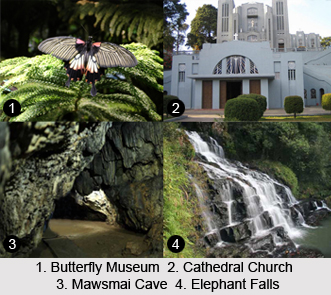 East Khasi Hills District is one of the seven districts of Meghalaya with its administrative headquarters located at Shillong. The district occupies an area of 2748 sq km. Khasi Hills District was divided into two districts namely East Khasi Hills District and West Khasi Hills District on 28th of October, 1976. On June 4th, 1992, East Khasi Hills District was further divided into two administrative districts of East Khasi Hills District and Ri-Bhoi District. The district consists of eight Community and Rural Development blocks at present. According to 2001 Census, total population of East Khasi Hills District is 2,306,069.
East Khasi Hills District is one of the seven districts of Meghalaya with its administrative headquarters located at Shillong. The district occupies an area of 2748 sq km. Khasi Hills District was divided into two districts namely East Khasi Hills District and West Khasi Hills District on 28th of October, 1976. On June 4th, 1992, East Khasi Hills District was further divided into two administrative districts of East Khasi Hills District and Ri-Bhoi District. The district consists of eight Community and Rural Development blocks at present. According to 2001 Census, total population of East Khasi Hills District is 2,306,069.
Location of East Khasi Hills District
East Khasi Hills District forms a central part of Meghalaya and East Khasi Hills District lies between 25 degree 7 minutes and 25 degree 41 minutes north latitude and 91 degree 21 minutes and 92 degree 9 minutes east longitude. This district of Meghalaya is bounded by Ri-Bhoi District in the north, Karbi Anglong District in the north east, Jaintia Hills District in the east, Bangladesh in the south and West Khasi Hills District in the west.
Geography of East Khasi Hills District
Geography of East Khasi Hills District is mostly hilly with deep gorges and ravines on the southern portion. The most important physiographic features of the district is Shillong Plateau interspersed with river valley, falling sharply in the southern portion forming deep gorges and ravine in Mawsynram and Shella-Bholaganj bordering Bangladesh. Shillong peak lying 10 kms from the city, offer a panoramic view of the scenic landscape and it is also the highest point in the district.
 Climate of East Khasi Hills District ranges from temperate in the plateau region to warmer tropical and sub-tropical pockets on the northern and southern regions. The district is influenced by the south-west monsoon which begins generally from May and continues till September. The weather is humid for the major portion of the year except for the relatively dry spell usually between December and March.
Climate of East Khasi Hills District ranges from temperate in the plateau region to warmer tropical and sub-tropical pockets on the northern and southern regions. The district is influenced by the south-west monsoon which begins generally from May and continues till September. The weather is humid for the major portion of the year except for the relatively dry spell usually between December and March.
Culture of East Khasi Hills District
Culture of East Khasi Hills District is a reflection of the traditions, cultures and religious beliefs of the tribal communities residing here. Khasi tribe mainly inhabits this district and thus, it can be said that the culture is chiefly tribal in character. Other tribal groups inhabiting the district are Garo Tribe and Jaintias. Art and craft, costumes, songs and dance forms and festivals like Nongkrem Dance and Shad Suk Mynsiem constitute the culture of East Khasi Hills District.
Tourism in East Khasi Hills District
Tourism in East Khasi Hills District offers visits to several sites that are worth visiting. The tourist attractions of this district attract people from different parts of the world. Some of the popular attractions of East Khasi Hills District are Ward`s Lake and Botanical Garden, Butterfly Museum, Meghalaya State Museum, Lady Hydari Park, Shillong Peak, Elephant Falls, Spread Eagle Falls, Cathedral Church, Mawsmai Cave, Mawsmai Falls, Nohkalikai Falls, Kynrem Falls, Mawjymbuin Caves, Symper Peak, Crinoline Falls, Laitshyngiar Cave, Thangkharang Park and more.
As per Census 2001, literacy rate of East Khasi Hills District is 63.31 percent out of which 66.14 percent is male literacy rate and 60.41 percent is the female literacy rate.



















